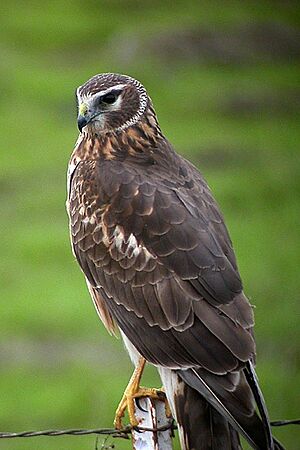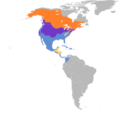Northern harrier facts for kids
Quick facts for kids Northern harrier |
|
|---|---|
 |
|
| Adult female | |
| Conservation status | |
| Scientific classification | |
| Genus: |
Circus
|
| Species: |
hudsonius
|
 |
|
| Breeding
Year-round Non-breeding Migration |
|
| Synonyms | |
|
Circus cyaneus hudsonius |
|
The northern harrier (Circus hudsonius), also known as the marsh hawk, is a type of bird of prey. It lives and breeds across the northern parts of the northern hemisphere. You can find it in Canada and the northern USA.
Northern harriers fly south for winter. Birds from Canada and the northern USA move to the American south, Mexico, and Central America. In some parts of the USA, like the Midwest, they might stay all year. These birds love open areas like prairies, fields, and marshes.
Contents
About the Northern Harrier's Name
The northern harrier got its scientific name, Circus hudsonius, from its history. In 1750, a naturalist named George Edwards drew and described this bird. He called it "The Ring-tail'd Hawk."
Edwards based his drawing on a bird found near Hudson Bay in Canada. Later, in 1766, Carl Linnaeus gave it the scientific name Falco hudsonius. The name hudsonius comes from Hudson Bay. Today, it's in the genus Circus, which means "circle" in Ancient Greek. This refers to how harriers often fly in circles.
What Does a Northern Harrier Look Like?


Northern harriers are medium-sized birds. They are about 41 to 52 centimeters (16 to 20 inches) long. Their wings can spread out 97 to 122 centimeters (38 to 48 inches) wide.
Male and female harriers look different. Males are lighter, weighing about 290 to 400 grams (10 to 14 ounces). Females are heavier, weighing 390 to 750 grams (14 to 26 ounces). Males are often called the "Grey Ghost." This is because of their striking grey feathers and quiet way of flying.
These birds have long wings and tails compared to their body size. This helps them fly low and hunt. Northern harriers are usually quiet. But they make quick kek sounds when they are near predators. Females make a loud scream during mating season.
Northern Harrier Behavior and Life Cycle
Northern harriers live in open areas. These include moorlands, bogs, prairies, and marshes. A male harrier usually controls a territory of about 2.6 square kilometers (1 square mile).
These birds are one of the few raptors that practice polygyny. This means one male mates with several females. Sometimes, one male can mate with up to five females in a season.
Nesting and Reproduction
Harriers build their nests on the ground. They might also build them on a small mound of dirt or plants. Nests are made of sticks and lined with grass and leaves. Females lay four to eight whitish eggs.
The female mostly sits on the eggs for 31 to 32 days. While she incubates, the male hunts and brings her food. After the chicks hatch, the male helps feed them. He usually passes food to the female, who then feeds the young. Later, the female might drop food directly into the nest.
Chicks learn to fly when they are about 36 days old. Females can start breeding at 2 years old. Males are ready to breed at 3 years old.
How Northern Harriers Hunt
Northern harriers hunt by flying low over fields. They hold their long wings in a shallow "V" shape. They mostly hunt small mammals like voles and ground squirrels. Small mammals make up about 95% of their diet.
They also hunt birds regularly, especially males. They catch small songbirds, shorebirds, and young waterfowl. Sometimes, they eat amphibians like frogs, reptiles, and insects. They have even been seen hunting bats.
Harriers surprise their prey by flying low. They circle an area, listening and looking for food. They have very good hearing for a bird of prey. This is thanks to their owl-like face, which helps them hear better.
Challenges and Threats
Northern harriers usually don't live very long. Most adults live less than 8 years. The oldest known harrier lived for 16 years and 5 months. Young harriers often die because of predators.
Predators of eggs and chicks include raccoons, skunks, badgers, foxes, crows and ravens, dogs, and owls. Young birds that have just learned to fly are also often hunted. Great horned owls are common predators of young harriers. Both parent harriers will attack predators to protect their nest.
Short-eared owls are natural rivals of northern harriers. They hunt the same prey and live in similar places. Sometimes, harriers and short-eared owls will try to steal food from each other. This is called kleptoparasitism. Harriers are usually the ones trying to steal from the owls.
Conservation Status
The northern harrier lives in a very large area. Its population has been declining, but not quickly enough to be a major concern. Because of this, the IUCN Red List classifies it as "least concern." This means it is not currently considered endangered.
Northern Harriers and People
Some Native American tribes believe that seeing a hawk on your wedding day means a long and happy marriage. Farmers have often liked harriers. This is because harriers eat mice that can damage crops. They also don't usually bother farm animals like chickens.
In the 1970s and 1980s, many harriers died. This was due to the heavy use of certain chemicals called pesticides.
Images for kids




